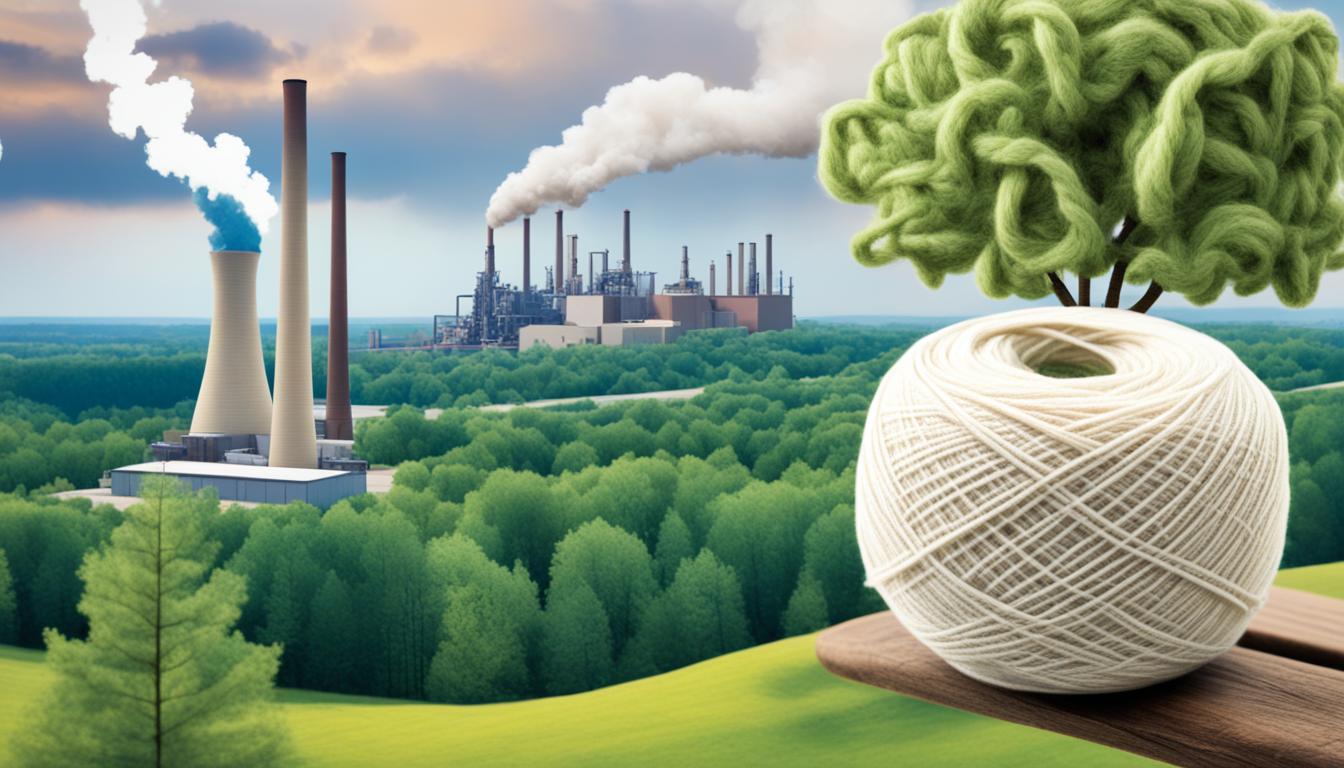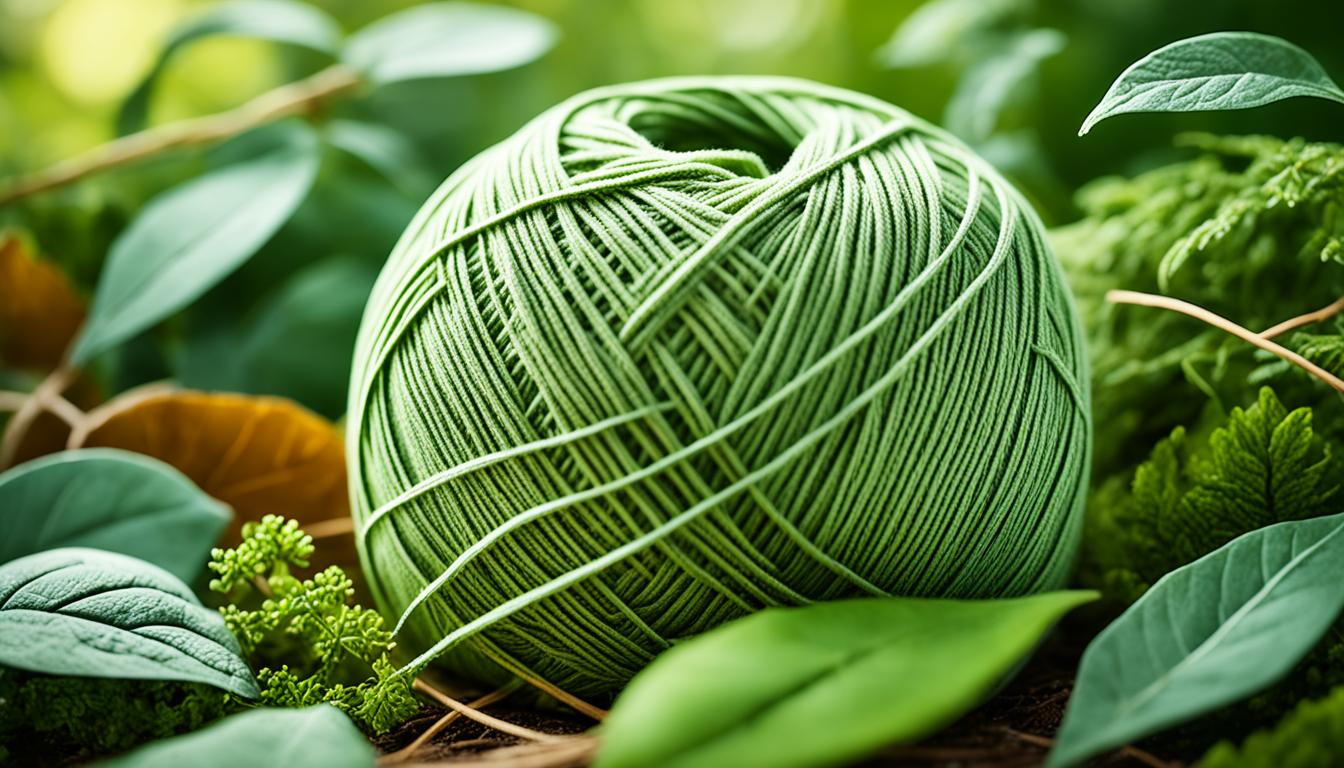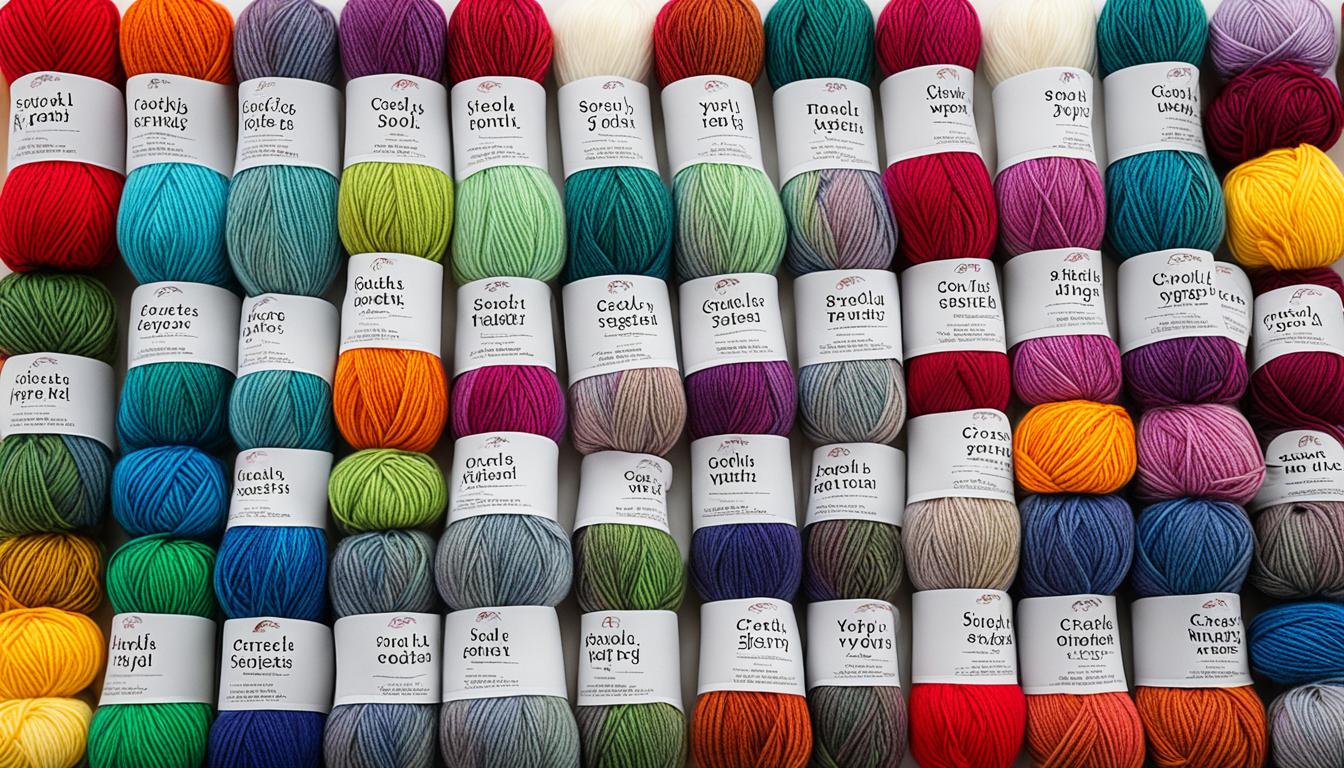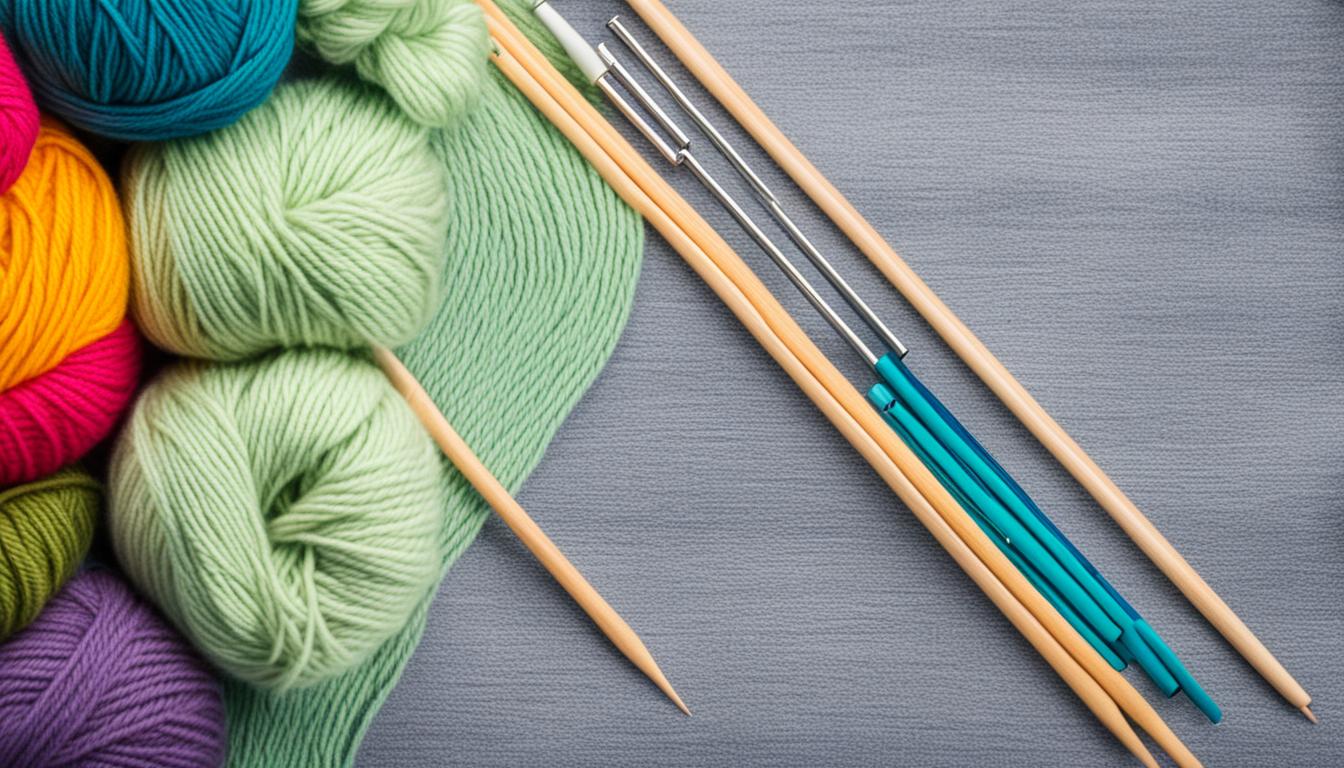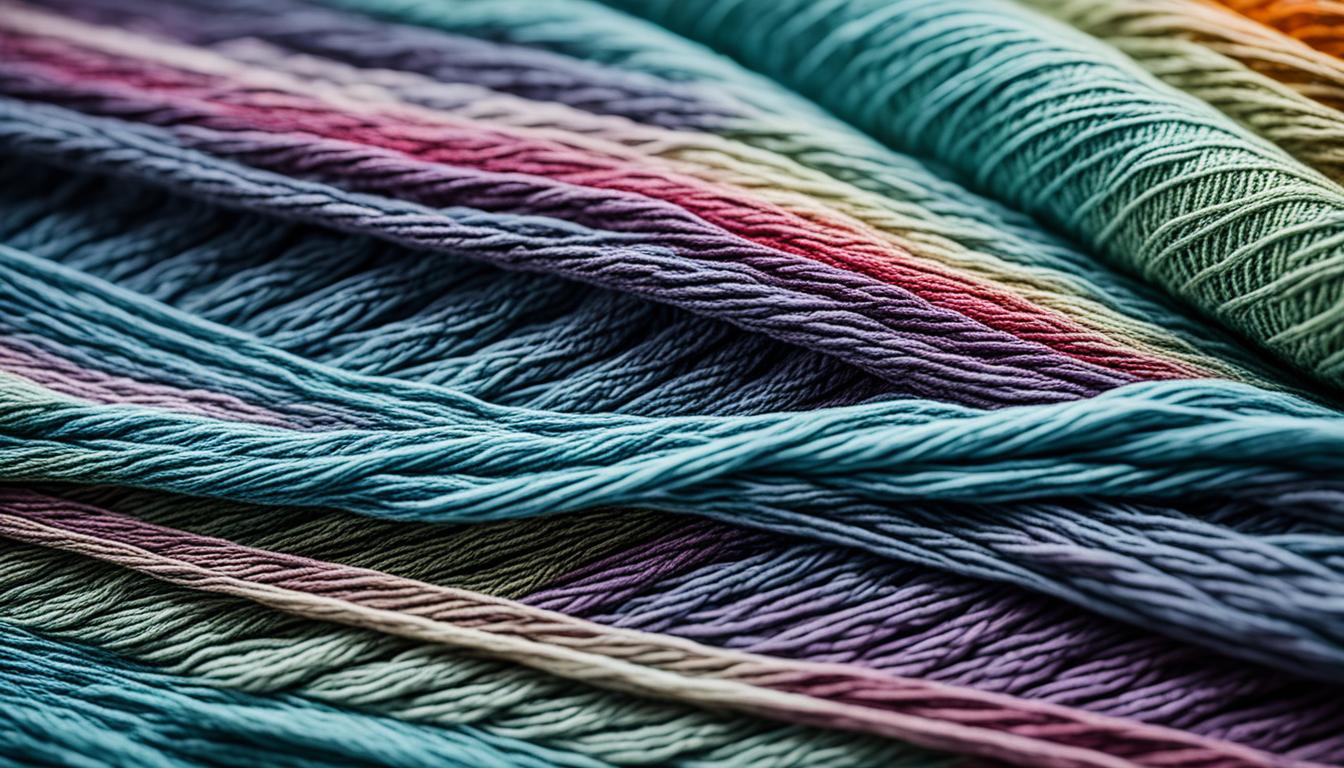When you imagine yarn, do you envision a warm sweater made from natural fibers or a colorful scarf crafted from synthetic materials? There are different types of yarn, but what sets natural fiber yarn apart from its manmade alternatives? Is one superior to the other? Let’s explore the realm of yarn and discover the realities about its beginnings, qualities, and ideal applications.
Key Takeaways:
- Yarn can be categorized as either natural fiber yarn or synthetic fiber yarn.
- Natural fiber yarn is made from materials that occur in nature, such as cotton, wool, silk, and linen.
- Synthetic fiber yarn is created through chemical processes using materials like acrylic, polyester, and nylon.
- Natural fiber yarn offers breathability, comfort, and a natural aesthetic, while synthetic fiber yarn provides affordability, durability, and versatility.
- Understanding the characteristics and properties of different yarn types can help you make informed crafting decisions.
Understanding Natural Fiber Yarn
Natural fiber yarn is highly regarded for its breathability, durability, and suitability for sensitive skin. The use of natural materials lends these yarns a unique set of characteristics that make them a popular choice among crafters. Let’s explore the different kinds of natural fiber yarn and delve into their production process and distinctive qualities.
Cotton Yarn
Cotton yarn is sought after for its softness, lightweight nature, and exceptional absorbency. It is ideal for warm-weather projects, as it allows for excellent breathability and moisture management. Cotton yarn is derived from the cotton plant, and the fibers are extracted through a series of processes, including shearing, carding, spinning, and dyeing. This yarn holds its shape well and is suitable for a variety of knitting and crocheting projects.
Wool Yarn
Wool yarn is known for its warmth, elasticity, and remarkable moisture-wicking properties. It is an excellent choice for colder climates, as it provides insulation without feeling heavy. Wool yarn is sourced from sheep and other animals, and its production involves similar processes as cotton yarn, such as shearing, carding, spinning, and dyeing. The unique structure of wool fibers allows them to trap air, providing excellent heat retention. Additionally, wool has the ability to regulate body temperature, making it a versatile choice for various projects.
Other Natural Fiber Yarns
In addition to cotton and wool, there are other natural fibers used in yarn production, such as silk and linen. Silk yarn is derived from silk worms and is known for its luxurious feel and lustrous appearance. Linen yarn, made from flax fibers, offers strength, durability, and a crisp texture. Each type of natural fiber yarn has its own set of characteristics, allowing crafters to explore a wide range of options for their projects.
“Natural fiber yarns, such as cotton and wool, possess unique qualities that can enhance your knitting or crocheting projects. From the softness of cotton to the warmth of wool, these yarns offer a delightful crafting experience.”
| Fiber Type | Characteristics |
|---|---|
| Cotton | Soft, lightweight, absorbent |
| Wool | Warm, elastic, moisture-wicking |
| Silk | Luxurious, lustrous |
| Linen | Strong, durable, crisp |
Exploring Synthetic Fiber Yarn
When it comes to choosing yarn for your projects, synthetic fiber yarn offers a wide range of advantages. One of the key benefits is its affordability, making it an excellent choice for budget-conscious crafters. In addition, synthetic fiber yarn is known for its versatility, as it can easily mimic the characteristics of various natural fibers such as cotton or wool. Whether you’re looking for softness, durability, or resistance to stretching, there’s a synthetic fiber yarn that fits your needs.
What sets synthetic fiber yarn apart is its engineered nature. Through a process known as yarn production, synthetic fibers are chemically created to exhibit specific characteristics. For example, acrylic yarn is known for its softness and lightweight feel, while polyester yarn offers excellent durability and resistance to wrinkles and stretching. This enables crafters to achieve consistent and reliable results in their projects.
The production of synthetic fiber yarn involves careful chemical processes like polymerization and extrusion. As a result, synthetic fibers are created with consistent properties, from the colorfastness to the strength and resistance to shrinkage. This ensures that synthetic fiber yarn can withstand the wear and tear of frequent use and maintain its shape and integrity over time.
When considering synthetic fiber yarn, it’s important to weigh the characteristics and advantages it offers. Take a look at the table below for a comparison of different synthetic fiber yarn types:
| Yarn Type | Characteristics |
|---|---|
| Acrylic Yarn | Soft, lightweight, and affordable |
| Polyester Yarn | Durable, resistant to stretching, and colorfast |
| Nylon Yarn | Strong, lightweight, and quick-drying |
As you can see, each type of synthetic fiber yarn has its own unique qualities that cater to different project requirements. Whether you’re creating cozy sweaters, durable blankets, or vibrant accessories, synthetic fiber yarn offers a multitude of options to bring your creative vision to life.
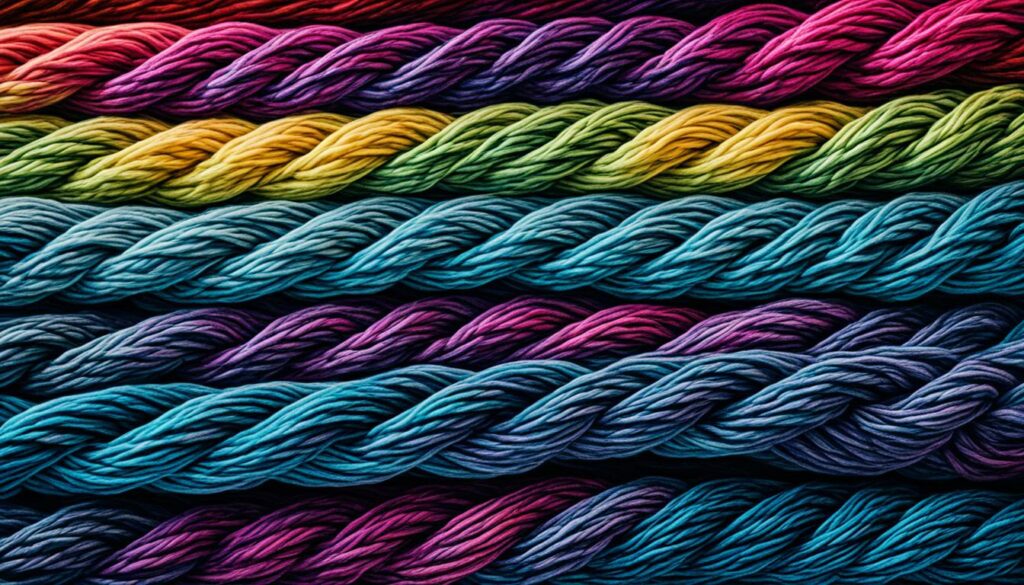
Infographic: Synthetic Fiber Yarn Characteristics
For a quick reference, here’s an infographic highlighting the characteristics of synthetic fiber yarn:
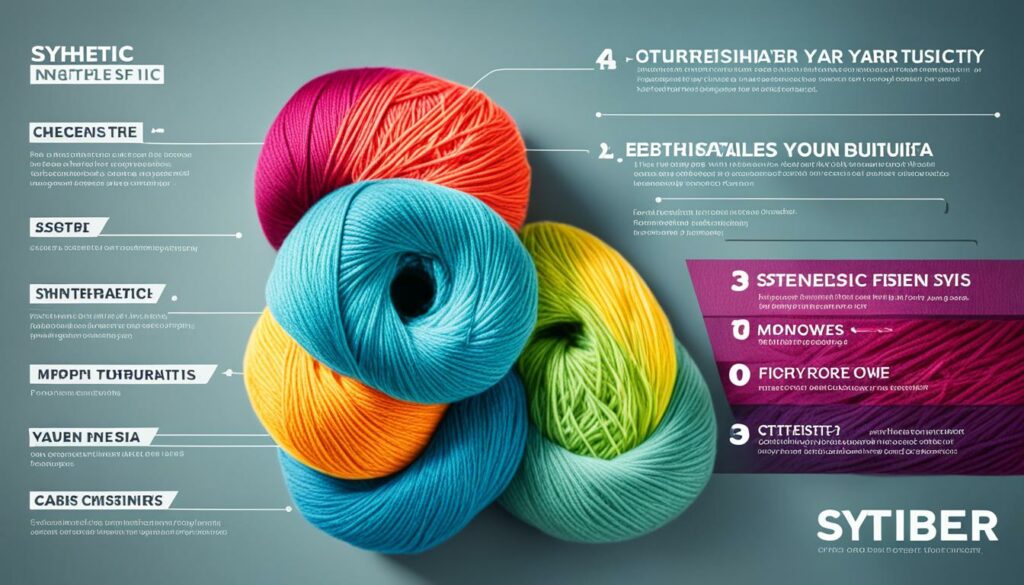
With synthetic fiber yarn’s affordability, versatility, and durability, it’s no wonder that it has become a popular choice among crafters. Whether you’re a beginner or an experienced yarn enthusiast, synthetic fiber yarn offers a world of creative possibilities.
Identifying Natural and Manmade Yarn
When choosing yarn for your next project, it’s important to be able to distinguish between natural and manmade yarn. One simple method for identifying the type of yarn is through a burn test. Natural fiber yarn, such as cotton or wool, will behave differently when burned compared to synthetic fiber yarn, like acrylic or polyester.
During a burn test, natural fibers will burn slowly and curl away from the flame. They may also leave behind a lingering smell similar to burning hair. On the other hand, synthetic fibers tend to burn more quickly and may melt or shrink. You may notice a distinct odor similar to burning plastic.
Characteristics of Natural and Synthetic Yarn
Natural fiber yarns have distinct characteristics that differentiate them from synthetic yarns. They often have a specific feel and appearance, with subtle variations in texture and sheen. Natural fiber yarns, like cotton and wool, may have slight imperfections and irregularities that add to their charm.
Synthetic fiber yarns, on the other hand, tend to have a more uniform texture and sheen. They are often created through chemical processes, resulting in fibers with consistent properties. Synthetic yarns can offer a wide range of colors and textures, making them ideal for projects that require specific aesthetics.
In a burn test, natural fiber yarn will burn slowly and curl away from the flame, while synthetic fiber yarn will burn more quickly and may shrink or melt. Natural fiber yarns have a unique feel and appearance, while synthetic fiber yarns often have a more uniform texture and sheen.
The production process for natural and synthetic yarn also differs. Natural fiber yarn is typically made from plant or animal materials that undergo processes like shearing, carding, spinning, and dyeing. These processes preserve the inherent qualities of the fibers and result in yarn with unique properties.
On the other hand, synthetic fiber yarn is produced through chemical processes like polymerization and extrusion. These processes allow for the creation of fibers with desired characteristics, such as strength, colorfastness, and resistance to wrinkles and shrinkage.
Comparison of Natural and Synthetic Yarn
| Natural Yarn | Synthetic Yarn |
|---|---|
| Derived from plant or animal materials | Created through chemical processes |
| Unique feel and appearance | Uniform texture and sheen |
| Subject to natural variations and imperfections | Consistent properties and colors |
| Generally biodegradable and renewable | Not biodegradable and made from non-renewable resources |

Understanding the differences between natural and synthetic yarn can help you make informed decisions when selecting yarn for your projects. Whether you prefer the unique qualities of natural fiber yarn or the versatility of synthetic fiber yarn, each type has its own set of characteristics and benefits. Consider your project requirements and personal preferences to find the perfect yarn for your next knitting or crocheting adventure.
The Benefits of Natural Fiber Yarn
Natural fiber yarn offers several benefits that make it a popular choice for crafters and fashion enthusiasts alike. Whether you’re knitting a cozy sweater or creating intricate crochet designs, here are some reasons why natural fiber yarn should be on your radar.
Biodegradable and Sustainable
Natural fiber yarn is biodegradable, meaning it can decompose over time without leaving behind harmful waste. Unlike synthetic fibers that contribute to plastic pollution, natural fiber yarns provide an eco-friendly alternative. By choosing natural fiber yarn, you’re making a sustainable choice and reducing your environmental impact.
Breathable and Comfortable
One of the standout characteristics of natural fiber yarn is its breathability. Yarns made from cotton, wool, silk, and other natural materials allow air to circulate, helping to regulate body temperature and keeping you comfortable in any season. The breathability of natural fiber yarns also makes them ideal for projects like lightweight summer garments.
Moisture-Wicking Properties
Natural fiber yarns have inherent moisture-wicking properties, meaning they can absorb moisture and draw it away from the skin. This feature makes natural fiber yarn perfect for creating cozy activewear, socks, or other items that come into contact with sweat. With natural fiber yarn, you can stay dry and comfortable during physical activities.
Unique Texture and Aesthetic
Each natural fiber presents its own unique texture and aesthetic appeal. Cotton yarn offers a soft and smooth feel, while wool yarn provides warmth, elasticity, and a cozy touch. The rich and luxurious look of silk yarn adds elegance to any project, while linen yarn offers a rustic and textured appearance. These distinct characteristics allow you to experiment with different yarns to achieve desired textures and appearances in your creations.
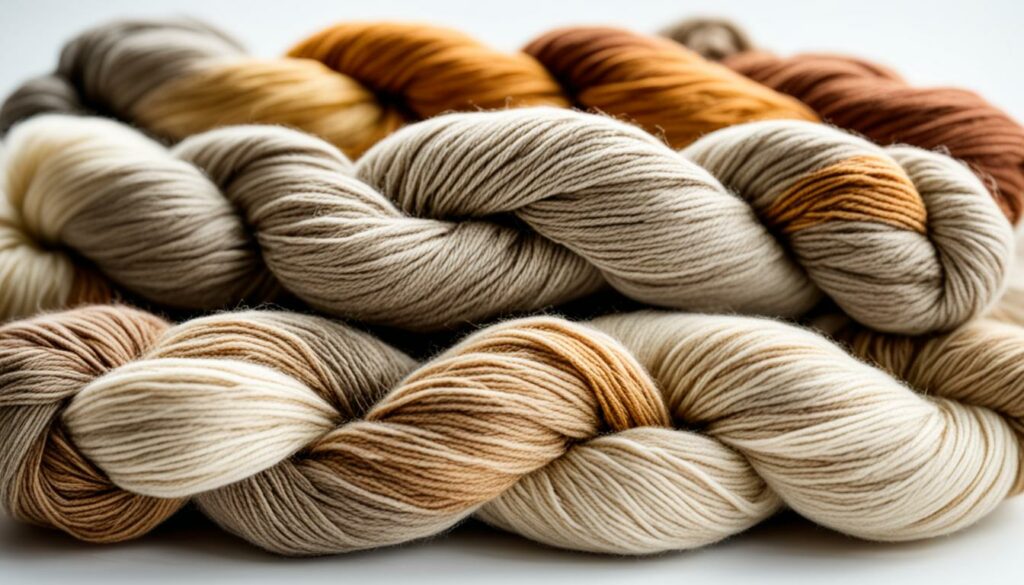
As you can see, natural fiber yarn brings numerous benefits to your projects. Not only is it sustainable and comfortable, but it also offers a wide range of unique textures and aesthetics. By incorporating natural fiber yarn into your knitting and crocheting, you can create beautiful, eco-friendly pieces that are as enjoyable to make as they are to wear.
The Advantages of Synthetic Fiber Yarn
Synthetic fiber yarn offers several advantages that make it a popular choice for various projects. Whether you’re a knitting enthusiast or a crochet lover, synthetic fiber yarn can be a versatile and practical option. Here are some key benefits of using synthetic fiber yarn:
- Affordability: Synthetic fiber yarn is often more budget-friendly compared to natural fiber yarn. This makes it a great choice for crafters who want to create beautiful projects without breaking the bank.
- Wide range of colors and textures: Synthetic fiber yarn is available in an extensive array of vibrant colors and textures. Whether you prefer a bold and eye-catching design or a subtle and soft texture, there’s a synthetic fiber yarn that suits your creative vision.
- Low maintenance: One of the advantages of synthetic fiber yarn is its resistance to wrinkles, shrinking, and fading. This makes it highly suitable for projects that require minimal care and can withstand regular use and washing.
- Allergy-friendly: For individuals with allergies to natural fibers like wool or silk, synthetic fiber yarn can be a great alternative. It doesn’t trigger common allergies and provides a comfortable crafting experience without any discomfort or irritation.
If you’re looking for an affordable, vibrant, and low-maintenance yarn option, synthetic fiber yarn is an excellent choice. Its wide range of colors and textures, coupled with its allergy-friendly nature, make it a go-to choice for many crafters. Experimenting with synthetic fiber yarn can add a unique touch to your projects and help you achieve stunning results.
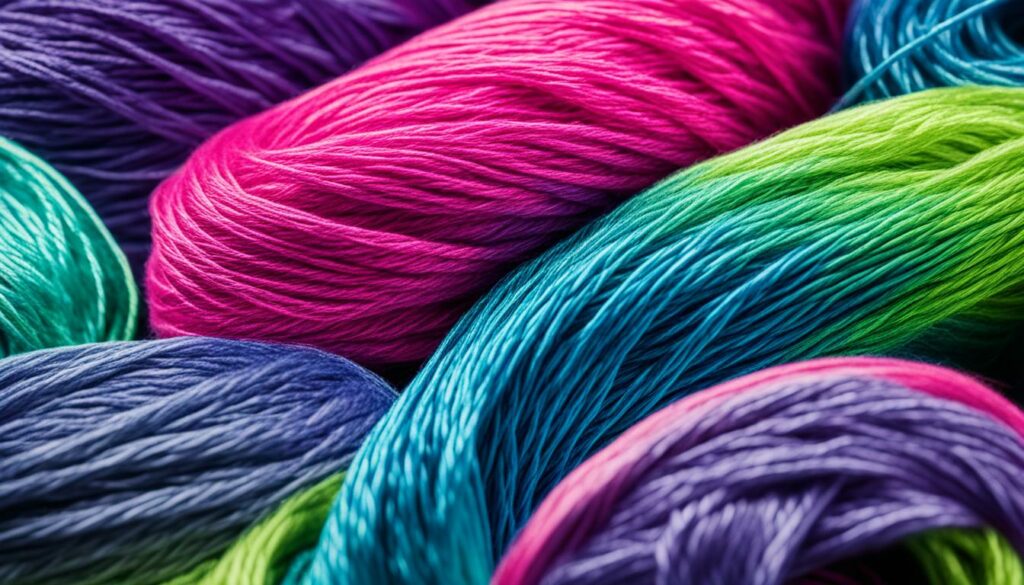
Choosing the Right Yarn for Your Project
When it comes to selecting yarn for your project, it’s important to consider the specific characteristics required for the item you are creating. Both natural fiber yarn and synthetic fiber yarn have unique qualities that make them suitable for different types of projects.
Natural fiber yarn is an excellent choice for garments, accessories, and items that come into direct contact with the skin. It offers breathability, comfort, and a natural aesthetic. Natural fiber yarn is made from materials like cotton, wool, silk, and linen, which are derived from nature. These yarns have a soft feel and can provide warmth or maintain coolness, depending on the type of fiber used. They are also known for their absorbency and ability to regulate body temperature. Natural fiber yarn is produced through processes like shearing, carding, spinning, and dyeing, preserving the inherent qualities of the fibers.
“`html
Natural fiber yarn is suitable for:
- Garments
- Accessories
- Items in direct contact with the skin
“`
Synthetic fiber yarn, on the other hand, is often preferred for items that need to retain their shape and durability. If you’re making blankets or outdoor gear, synthetic fiber yarn is a great option. Synthetic fibers like acrylic, polyester, and nylon are engineered through chemical processes to have specific characteristics such as strength, colorfastness, and resistance to wrinkles and shrinkage. Acrylic yarn, for instance, is known for its softness and affordability, while polyester yarn is durable and resistant to stretching. Synthetic fiber yarn is produced through processes like polymerization and extrusion, resulting in fibers with consistent properties.
“`html
Synthetic fiber yarn is suitable for:
- Blankets
- Outdoor gear
- Items requiring shape retention and durability
“`
When choosing the right yarn for your project, don’t be afraid to experiment with different types. Each type of yarn offers its own unique set of qualities and benefits. By understanding the characteristics of both natural and synthetic fiber yarns, you can make informed decisions and create beautiful, functional items that suit your needs.
Next, let’s explore some tips for working with natural and synthetic yarn to ensure successful projects.
Tips for Working with Natural and Synthetic Yarn
Working with yarn can be a delightful and creative experience, whether you’re using natural fiber yarn or synthetic fiber yarn. Each type of yarn has its own unique characteristics and requires a slightly different approach. Here are some useful tips to help you make the most of your knitting or crocheting projects:
Working with Natural Fiber Yarn
When working with natural fiber yarn, it’s important to take into account its inherent qualities and properties. Here are some tips to keep in mind:
- Pay attention to blocking: Natural fiber yarn has memory, which means it can easily be shaped. This makes it important to block your finished projects to ensure that they maintain their desired shape. Blocking involves gently shaping your project by wetting or steaming it and allowing it to dry in the desired shape.
- Handle with care: Natural fiber yarn, such as cotton, wool, silk, or linen, can be more delicate compared to synthetic yarn. Take care when handling, as it can potentially shrink or felt if exposed to high temperatures or harsh agitation. Follow the washing instructions provided on the yarn label to ensure proper care.
- Consider fiber-specific techniques: Different natural fiber yarns may require specific techniques. For example, wool yarn benefits from gentle blocking with water, while linen yarn typically benefits from steam blocking.
Working with Synthetic Fiber Yarn
Synthetic fiber yarns, such as those made from acrylic, polyester, or nylon, offer their own set of advantages. Here are some tips to keep in mind when working with synthetic fiber yarn:
- Be mindful of blocking: Synthetic fiber yarn is generally less likely to shrink compared to natural fiber yarn. However, it may not hold blocking as well. Keep this in mind when shaping your projects and consider alternative blocking methods.
- Be aware of static electricity: Synthetic fiber yarn can be more prone to static electricity, which can be noticeable when wearing or working with the yarn. Consider using anti-static sprays or fabric softeners to help reduce static.
- Experiment with different stitches: Synthetic fiber yarns often have a more uniform texture and can be forgiving when it comes to stitch mistakes. This makes it a great option for trying out new stitches or patterns.
Remember, regardless of the type of yarn you choose, experimenting with different techniques and learning from your experiences will help you become more comfortable and skilled in working with yarn. Don’t be afraid to try new things and let your creativity flow!
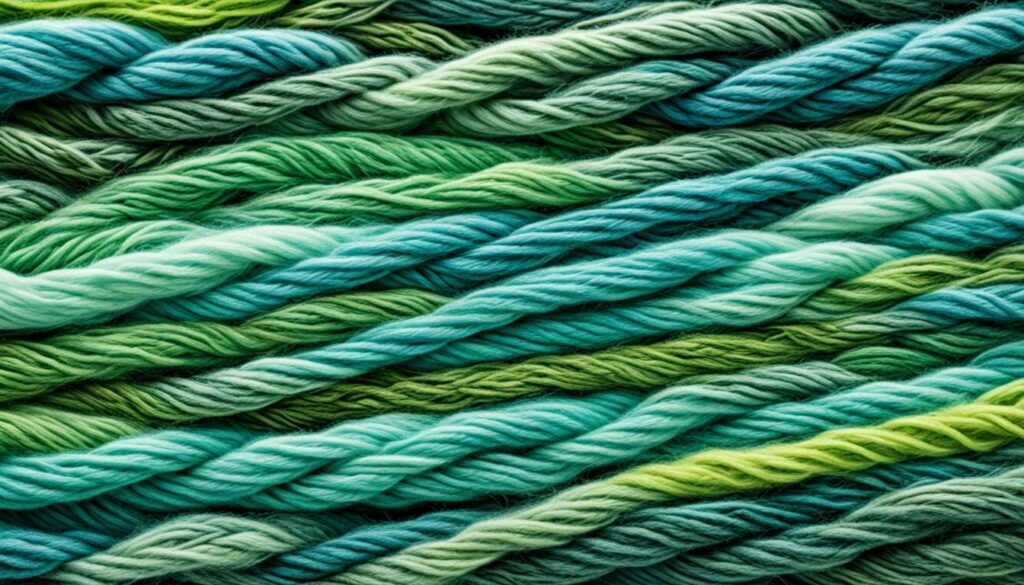
| Working with Natural Fiber Yarn | Working with Synthetic Fiber Yarn |
|---|---|
| Natural fiber yarn has memory and can easily be shaped. Pay attention to blocking and gently shape your projects to maintain their desired shape. | Synthetic fiber yarn is less likely to shrink, but it may not hold blocking as well. Be mindful of the blocking techniques you use. |
| Natural fiber yarn can shrink or felt if not handled properly. Follow the washing instructions on the yarn label to ensure proper care. | Synthetic fiber yarn can be more prone to static electricity. Use anti-static sprays or fabric softeners to reduce static. |
| Consider fiber-specific techniques for different natural fiber yarns. For example, wool benefits from gentle blocking with water, while linen yarn typically benefits from steam blocking. | Synthetic fiber yarn often has a more forgiving nature and can be great for experimenting with different stitches and patterns. |
Caring for Natural and Synthetic Yarn
Proper care and maintenance are essential for keeping your natural fiber yarn and synthetic fiber yarn in top condition. By following a few simple guidelines, you can ensure that your yarn retains its quality and lasts for years to come.
Caring for Natural Fiber Yarn
Natural fiber yarn, such as cotton, wool, silk, and linen, requires gentle washing and special attention. Here are some tips for caring for your natural fiber yarn:
- Washing: Hand wash natural fiber yarn using a mild detergent in cool water.
- Drying: After washing, reshape the garment or item made from natural fiber yarn and lay it flat to dry. This helps maintain the shape and prevent stretching.
- Storage: Store natural fiber yarn in a cool, dry place to prevent damage from moths or humidity. Avoid storing it in plastic bags, as these can trap moisture.
By following these care instructions, you can keep your natural fiber yarn looking and feeling its best.
Caring for Synthetic Fiber Yarn
Synthetic fiber yarn, such as acrylic, polyester, and nylon, is generally easier to care for and more durable. Here are some tips for caring for your synthetic fiber yarn:
- Washing: Synthetic fiber yarn can usually withstand machine washing. Follow the care instructions on the yarn label.
- Drying: Synthetic fiber yarn can be dried in a machine dryer, but it’s best to use low heat or air dry to prevent excessive pilling.
- Pilling: Over time, synthetic fiber yarn may develop small fiber balls called pills. You can remove pills using a fabric shaver or carefully snipping them off with sharp scissors.
With proper care, your synthetic fiber yarn will remain soft, vibrant, and resistant to wear and tear.
Remember, whether you’re working with natural fiber yarn or synthetic fiber yarn, it’s important to read the care instructions on the yarn label and consider any specific recommendations from the yarn manufacturer.
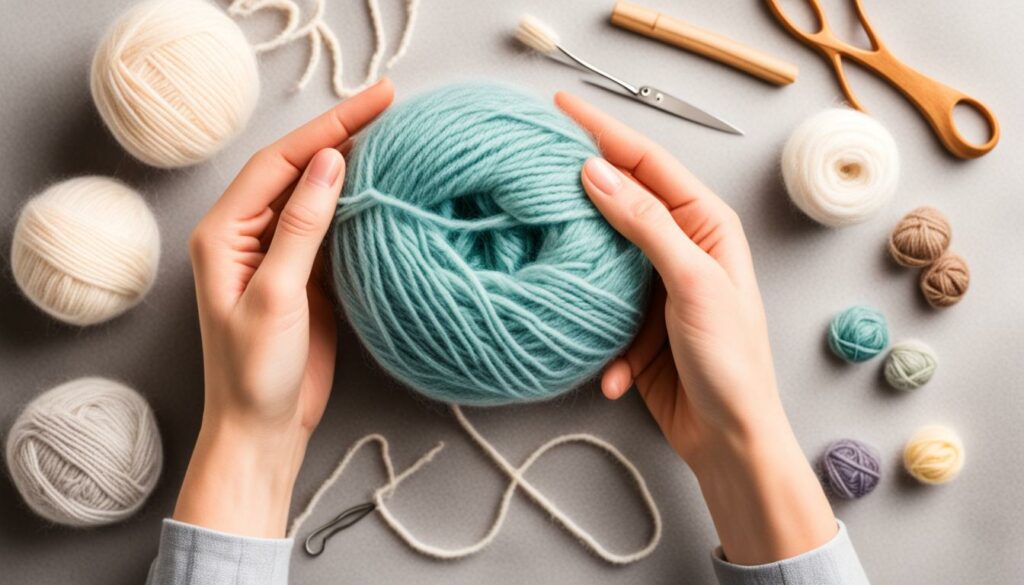
Following these care guidelines will help you keep your yarn in excellent condition, ensuring that you can enjoy your knitting or crocheting projects for years to come.
Exploring Yarn Sustainability
When it comes to sustainability, choosing the right yarn materials is crucial. Natural fiber yarn, such as cotton and wool, is often considered more eco-friendly due to its biodegradability and renewable sources. These yarns are derived from plants and animals, making them a sustainable choice for those concerned about the environment.
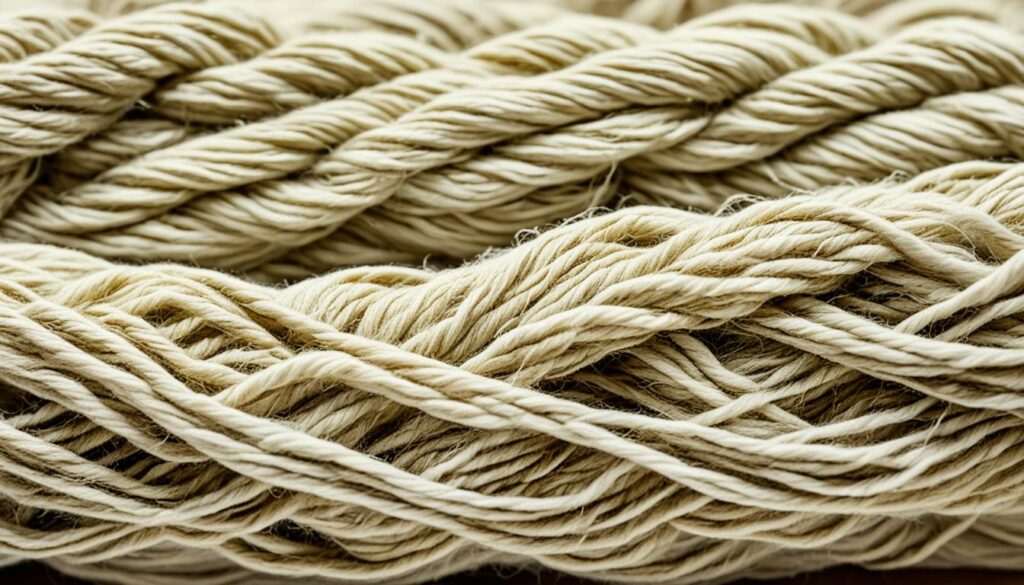
However, synthetic fiber yarn can also contribute to sustainability efforts. Many synthetic yarns are made from recycled materials, reducing waste and decreasing the demand for new resources. Additionally, advancements in manufacturing processes have enabled the production of synthetic fibers in a more sustainable manner.
When making sustainable choices, consider the environmental impact of the materials used in the production of yarn. Take into account factors such as the energy consumption, water usage, and chemical treatments involved in the manufacturing process. Look for certifications or labels that indicate environmentally friendly practices, such as organic or recycled materials.
Another consideration is the lifespan and recyclability of the yarn. Natural fiber yarns, although biodegradable, may have a shorter lifespan than synthetic fiber yarns. However, they can easily decompose and return to the earth, minimizing their impact on the environment. On the other hand, synthetic fiber yarns can be recycled and made into new products, extending their lifespan and reducing waste.
“The choices we make in our crafting projects can have a positive impact on the environment. By opting for sustainable yarn materials, we contribute to the conservation of natural resources and reduce our carbon footprint.”
| Yarn Type | Benefits | Considerations |
|---|---|---|
| Natural Fiber Yarn | – Biodegradable | – Shorter lifespan |
| Synthetic Fiber Yarn | – Made from recycled materials | – Long lifespan |
Ultimately, the choice between natural fiber yarn and synthetic fiber yarn depends on your project’s specific requirements and your own sustainability goals. By being mindful of the materials used in crafting, we can contribute to a greener future and enjoy our creative endeavors guilt-free.
The Future of Yarn Innovation
The yarn industry is constantly evolving, driven by advancements in technology and a growing focus on sustainability. Exciting developments in yarn production, materials, and types are shaping the future of this beloved craft. Let’s explore some of the innovative trends that are revolutionizing the world of yarn.
Recycled Yarns: Eco-Friendly and Stylish
Recycled yarns are gaining popularity as a sustainable alternative to traditional yarn materials. These yarns are made from post-consumer or post-industrial waste, such as plastic bottles or textile remnants, that are transformed into new fibers. By diverting waste from landfills, recycled yarns contribute to a circular economy and reduce the environmental impact of yarn production. Additionally, these eco-friendly yarns come in a variety of colors and textures, allowing crafters to create beautiful and unique projects.
Plant-Based Synthetics: Nature-Inspired Yarns
Plant-based synthetic yarns are another exciting innovation in the world of yarn. These yarns are derived from renewable sources such as bamboo, hemp, or corn. They offer the benefits of synthetic fiber yarns, such as durability and easy care, while also providing a more sustainable option. Plant-based synthetics can be blended with natural fibers or used on their own, offering versatile options for various projects. Crafters can enjoy the performance of synthetic yarns while minimizing their environmental footprint.
Biodegradable Fibers: Sustainable and Earth-Friendly
Biodegradable fibers are revolutionizing the yarn industry and addressing the issue of microplastic pollution. These fibers are designed to break down naturally over time, reducing their impact on the environment. Materials such as lyocell and hemp are known for their biodegradability, as they can be composted or decomposed without releasing harmful toxins. Crafters who prioritize sustainability can now choose biodegradable yarns to create beautiful projects while minimizing their ecological impact.
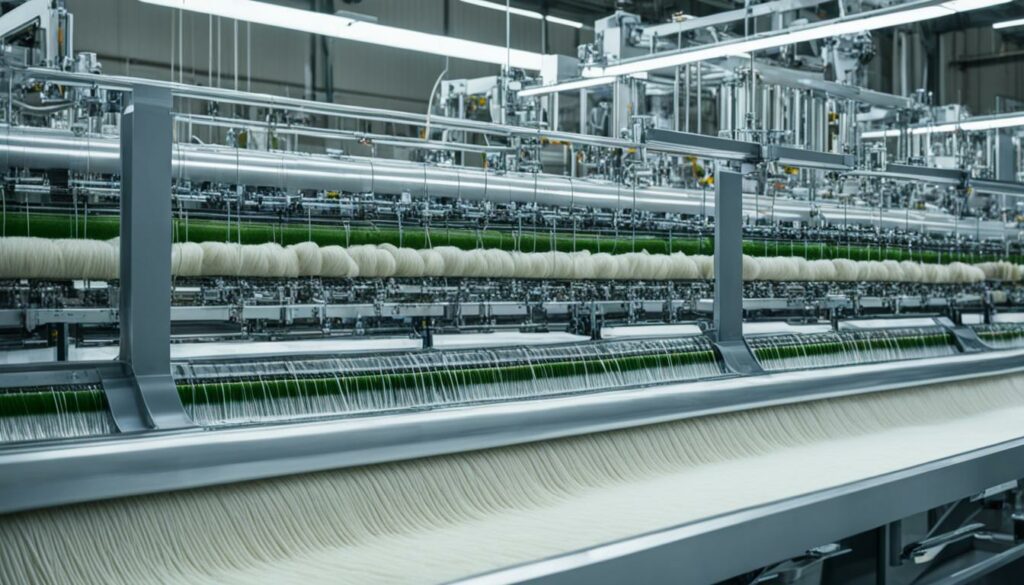
With these innovative advancements in yarn production, materials, and types, the future of yarn is brighter than ever. Crafters now have access to a wide range of sustainable and performance-driven options. Whether you prefer recycled yarns, plant-based synthetics, or biodegradable fibers, there are exciting choices for every project.
Comparison Table: Yarn Innovations at a Glance
| Yarn Innovation | Benefits |
|---|---|
| Recycled Yarns | – Sustainable – Wide range of colors and textures – Reduces waste |
| Plant-Based Synthetics | – Renewable – Durable and easy care – Nature-inspired fibers |
| Biodegradable Fibers | – Sustainable – Minimizes microplastic pollution – Compostable or decomposable |
As the yarn industry continues to innovate, new possibilities emerge for crafters seeking sustainable and performance-driven options. Stay tuned for exciting developments in yarn production, as well as advancements in materials and types that can inspire and enhance your future projects.
Conclusion
When it comes to choosing yarn for your knitting or crocheting projects, you have the option of natural fiber yarn or synthetic fiber yarn. Natural fiber yarn, made from materials like cotton, wool, silk, and linen, offers breathability, comfort, and a natural aesthetic. On the other hand, synthetic fiber yarn, created using materials like acrylic, polyester, and nylon, provides affordability, durability, and versatility.
Understanding the characteristics and properties of different yarn types is crucial in making informed decisions. Natural fiber yarn is known for its breathability, durability, and suitability for sensitive skin. It is produced through processes like shearing, carding, spinning, and dyeing, preserving the inherent qualities of the fibers. Synthetic fiber yarn, on the other hand, is engineered to have specific characteristics like strength and colorfastness. It is created through chemical processes like polymerization and extrusion, resulting in fibers with consistent properties.
Whether you prioritize the breathability and natural appeal of natural fiber yarn or the affordability and versatility of synthetic fiber yarn, both options have their own unique qualities and benefits. So the next time you embark on a knitting or crocheting project, consider the yarn materials and their production processes to ensure you choose the most suitable yarn. Happy crafting!
